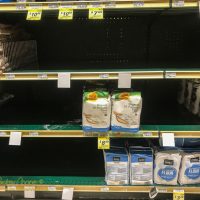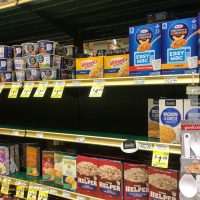Eating habits in our communities have drastically changed. The most obvious evidence of this is the consistently bare shelves in the local supermarket.
Going out to do our weekly grocery shopping I wander the isles and make note of empty store shelves that were never empty before. There is a theme in those empty shelves, a pattern that reveals that how we eat has changed in substantial ways.
One of the first things to disappear from our local grocery were what I consider comfort foods… Boxes of Kraft macaroni and cheese, tins of biscuit dough, and that Hawaiian favorite SPAM. In those early days of stay at home orders people bought foods that were familiar from childhood, offering a reassurance of normalcy, at least in the kitchen.
Many of these foods remain in short supply. I note the Kraft Mac and Cheese is a shelf that has been empty for six months now, it has become a curious sign of the times I continue to check on.
Here is a simple meal from a box that takes little effort to prepare, easy for the inexperienced cook forced to prepare home meals. A meal ever popular with young children, a meal that many recall fondly from their own childhoods.
I note that it is only the Kraft Mac and Cheese that remains scarce, the Anne’s and store brands are there. The Kraft instant mac is available, it is the classic box kit with uncooked pasta and the packet of cheese powder that leaves a large empty supermarket shelf in its absence.
A similar feature is the lack of Pillsbury biscuit dough and ready to bake Tollhouse chocolate chip dough. another set of consistently empty shelves. The cake and brownie mix shelves routinely have large gaps. Wandering the market will reveal other similar out-of-stock items.
Another notable gaping hole can be found in baking goods… Flour, sugar, and chocolate chips have been consistently scarce. These routinely feature on the shopping lists my wife texts to my phone. I travel the baking need aisle, phone in hand looking to grab another five pounds of flour. Like many others we have been baking more, the big mixer more often out on the counter than put away in the pantry.
It is no surprise that frozen meals that can be prepared with little effort are also hit hard. Frozen pizza is particularly scarce, our end-cap freezer case showing big empty shelves and a slim selection in what is left. Foods like frozen pizza are a direct replacement for a food that would have been eaten out or ordered as takeout before.
I suspect that our local market is particularly vulnerable to shortages. On this island we are at the tail end of a very long supply chain. Any shortages in the system appear quite quickly here, with back-orders and stocking issues magnified by long shipping times.
Six months into this pandemic production has been able recover from the early panic buying of toilet paper and baby wipes. As expected these products have reappeared as use of many items has really not changed. While production of priority products like hand sanitizer has adjusted to the new demand.
It is in the supply of many other products that we see where our supplies have not yet changed to meet the new demands. Baking products, favorite home meals, replacements for eating out, these products remain in tight supply.
The patterns of demand that food manufacturers have been accustomed to for decades have drastically shifted. They knew to a pound how much flour was needed to fill store shelves and how much to have ready for the holiday baking season. Those patterns are gone in the wake of SARS-CoV-2.
How long will it take for new production to come online to meet these new demands? Will these demands remain after the pandemic eases? There have certainly been tough conversations in food company board rooms lately.
So many of us had become accustomed to eating out for many meals. The abundance of good restaurants and good food had shifted our eating habits. The risks of eating out with a virus haunting our communities has changed that, so many of those restaurants have closed, many will not open again.
I wonder if these shifts in our eating habits will remain in years to come? I can only hope that families that have learned to cook again continue to do so, at least a bit more.






I suspect some/much of what you are seeing is at this point somewhat unique to being on an island in the middle of the ocean.
Certainly here in central Canada most of those empty shelves are now restocked – flour is back in regular availability for the most part and even yeast (which was delayed by the need to grow it) is available again.
And don’t think Spam or Kraft Dinner ever were not available.
More of debs cookies yum
It sound worse for you than here on the Main Land. We too have some shortages but the pizza and Mac & cheese and like are okay. Bread flour, yeast and other basic items are the ones tending to be short here. Delivery appears to be the main problem for an area of empty shelves one week will be well stocked the next. It is always an adventure shopping to fill out the list in hand. Mom